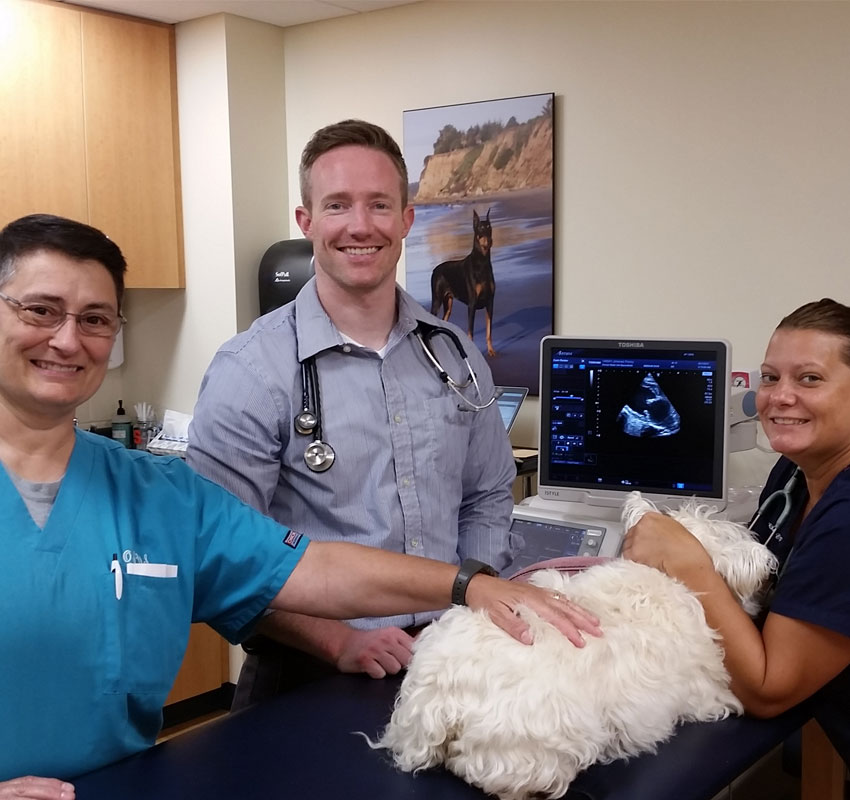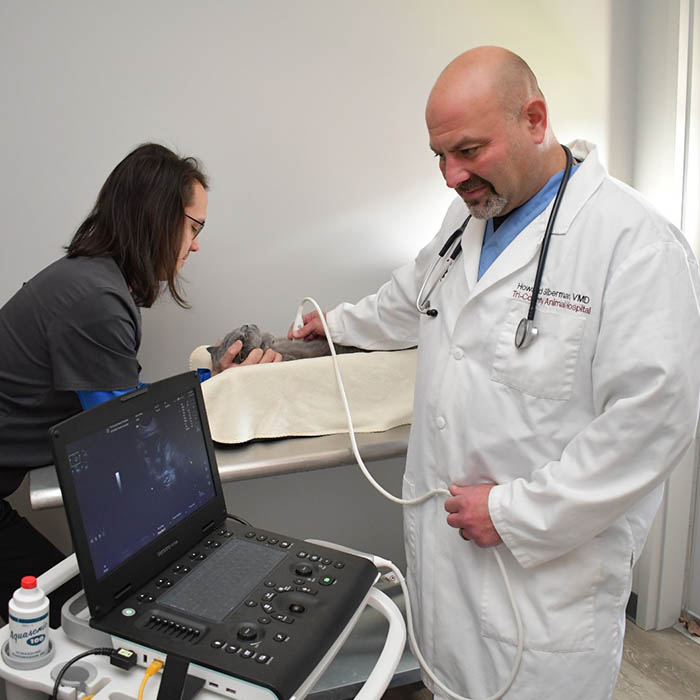The Duty of Ultrasound and CT Check in Modern Vet Practices: Insights From Experienced Professionals
In contemporary vet methods, ultrasound and CT scans substantially enhance analysis capacities. These imaging techniques offer crucial understandings into animal wellness, assisting therapy choices. Experienced experts acknowledge the special advantages of each modality. Ultrasound offers real-time assessments, while CT scans supply complex physiological information. Recognizing their applications and roles increases important inquiries about their influence on client outcomes and the future of veterinary diagnostics. What insights can be obtained from their integrated use?
Recognizing Ultrasound in Vet Medicine
Ultrasound is a vital analysis tool in vet medicine, offering a non-invasive method to imagine internal frameworks. This imaging strategy uses high-frequency acoustic waves to create real-time pictures of organs and tissues, allowing vets to assess problems without medical treatment. Typical applications include examining the heart, liver, kidneys, and reproductive organs, as well as keeping track of pregnancies.The procedure is relatively quick and can be performed in various setups, making it an accessible alternative for vets. Unlike radiography, ultrasound supplies comprehensive information regarding soft tissues and blood flow, which is essential for accurate diagnoses.Veterinary professionals depend on ultrasound to identify problems such as tumors, cysts, and liquid build-up. Its ability to assist biopsies and other treatments additionally enhances its utility in clinical technique. By using a secure and efficient method to check out interior anatomy, ultrasound has actually ended up being a foundation of modern vet diagnostics.
The Benefits of CT Scans for Pet Diagnostics
CT checks offer significant advantages in veterinary diagnostics by providing improved accuracy in recognizing interior problems (Ultrasound For Dogs). As a non-invasive imaging strategy, they guarantee the security and convenience of pets during exams. Additionally, CT checks promote an extensive assessment of inner structures, enabling more reliable treatment planning
Enhanced Diagnostic Precision
Innovations in imaging technology have substantially improved diagnostic precision in veterinary medication, specifically with using CT scans. These scans provide detailed cross-sectional photos of an animal's interior structures, allowing veterinarians to recognize abnormalities with accuracy. The high resolution and three-dimensional capacities of CT imaging help with the detection of problems such as growths, fractures, and internal bleeding that could be missed out on with conventional imaging approaches. In addition, CT scans can assist in pre-surgical preparation by providing a comprehensive view of anatomical connections. This level of detail not only improves the accuracy of medical diagnoses but additionally help in tailoring effective treatment plans. The combination of CT innovation right into veterinary practices is transforming the landscape of animal healthcare, improving results for clients.
Non-Invasive Imaging Technique
The intro of non-invasive imaging methods has actually reinvented pet diagnostics, with CT scans becoming a popular tool in veterinary techniques. These scans give high-resolution, cross-sectional photos of an animal's inner frameworks, permitting veterinarians to evaluate intricate problems without the demand for invasive treatments. The advantages of CT scans include their ability to spot tumors, fractures, and inner bleeding with remarkable accuracy. Furthermore, they help with the evaluation of soft tissues and body organs, boosting diagnostic capabilities. The speed of CT scanning allows fast decision-making, which is crucial in emergency scenarios. By minimizing anxiety and pain for the animal, CT scans add to an extra humane approach to diagnostics, ultimately boosting treatment end results and advancing vet care.
Comprehensive Internal Assessment
A thorough inner evaluation is crucial for precise medical diagnosis and effective treatment in vet medication. CT checks offer significant advantages in this respect, providing in-depth cross-sectional photos of an animal's interior frameworks. This sophisticated imaging method enhances visualization of complicated anatomical regions, making it possible for veterinarians to determine problems such as tumors, fractures, and inner bleeding with higher accuracy. On top of that, CT scans assist in the analysis of problems that might be challenging to detect via conventional techniques. The rate and precision of CT imaging also add to timely treatments, boosting patient outcomes. As vet methods significantly include CT modern technology, the benefits of substantial inner analyses end up being apparent, strengthening the value of this device in modern-day vet diagnostics.
Contrasting Ultrasound and CT Imaging Techniques
While both ultrasound and CT imaging offer crucial roles in vet diagnostics, each technique offers unique advantages and limitations that can influence clinical decision-making. Ultrasound is especially valued for its real-time imaging abilities, allowing veterinarians to observe vibrant physical procedures. This method is non-invasive, mobile, and does not involve ionizing radiation, making it a safer choice for both clinicians and pets. However, ultrasound might have constraints in visualizing certain physiological frameworks or deep tissues.Conversely, CT imaging supplies thorough cross-sectional sights of the body, enabling for accurate localization of irregularities. It masters examining complex body organs and frameworks, especially in the thorax and abdomen. However, CT scans need sedation or anesthesia in a lot of cases and include direct exposure to ionizing radiation. Inevitably, the option between ultrasound and CT depends upon the specific scientific scenario, the location of rate of interest, and the necessity of the analysis requirements.
Instance Studies: Effective Diagnoses Via Imaging
Study highlight the significant improvements in diagnostic precision achieved via sophisticated imaging innovations like ultrasound and CT scans in veterinary techniques. These advancements not just boost the detection of numerous conditions however likewise help with timely and effective therapy strategies. Examining certain situations can highlight the transformative influence of these imaging strategies on vet medication.
Diagnostic Accuracy Improvements

Imaging Innovation Advancements
As veterinary imaging innovation remains to develop, its effect on analysis capabilities comes to be increasingly noticeable. Recent study highlight the effective application of sophisticated ultrasound and CT check techniques in determining complex conditions. A veterinary clinic utilized high-resolution CT scans to detect a rare kind of lung cancer cells in a pet, which standard imaging had missed out on. In a similar way, an ultrasound assessment revealed a stomach mass in a cat, prompting prompt surgical treatment and a favorable end result. These innovations not only boost analysis precision yet also make it possible for veterinarians to design targeted therapy plans. By leveraging innovative imaging technologies, vet specialists are noticeably enhancing client treatment, leading to extra effective management of various wellness problems in animals.
The Role of Imaging in Emergency Situation Veterinary Care
Imaging plays an important role in emergency situation vet care, providing vets with vital info required to make rapid, enlightened choices. In immediate scenarios, techniques like ultrasound and CT scans enable experts to rapidly analyze an animal's interior structures, determining important problems such as interior blood loss, cracks, or organ problems. These imaging techniques permit real-time examinations, facilitating prompt interventions that can be life-saving. As an example, ultrasound is very useful for examining soft tissue injuries and problems like liquid accumulation, while CT checks deal thorough pictures of complicated anatomical structures, essential for identifying injury instances. The speed and accuracy of these imaging strategies boost the veterinarian's capability to create effective therapy strategies, making certain the finest possible results for their clients. The assimilation of innovative imaging technologies right into emergency vet techniques is not just helpful but progressively needed, as it improves diagnostic capacities and enhances general animal care throughout critical moments.

Training and Know-how in Veterinary Imaging
Although advanced imaging strategies such as ultrasound and CT scans are necessary for efficient veterinary care, the effective implementation of these modern technologies heavily relies on the training and proficiency of veterinary experts. Proficient use imaging devices needs complete expertise of anatomy, pathology, and the principles underlying each technique. Vet experts have to Read Full Report undergo specialized training to properly analyze imaging results, which is vital for diagnosing problems and intending treatment.Certifications and proceeding education and learning in vet imaging enhance the abilities of practitioners, allowing them to remain upgraded with technological innovations. Partnership between veterinarians and radiologists frequently leads to enhanced analysis precision, as professionals can supply insights into complex cases. Additionally, functional experience in handling imaging equipment fosters confidence in its application. Inevitably, the quality of veterinary imaging services is straight correlated to the degree of training and expertise had by the professionals using these essential analysis devices.
Future Trends in Diagnostic Imaging for Animals
With the fast developments in technology, veterinary analysis imaging is poised for considerable development in the coming years. Arising trends suggest a change towards even more easily accessible and portable imaging modalities, such as handheld ultrasound tools, which might enhance area diagnostics. Furthermore, the integration of artificial knowledge is anticipated to transform photo evaluation, permitting quicker and much more accurate analyses of results.Moreover, advancements in 3D imaging strategies and calculated tomography will offer vets with more complete sights of pet makeup, leading to improved treatment strategies. Online fact modern technology might also contribute in medical planning and education and learning, offering veterinarians an unique point of view on complicated cases.As telemedicine continues to expand, remote assessments assisted in by diagnostic imaging will certainly come to be a lot more usual, permitting experts to assist basic practitioners in real-time. Generally, these trends are readied to improve the effectiveness and performance of vet care, eventually improving animal outcomes.
Often Asked Inquiries
Just How Much Do Ultrasound and CT Scans Expense in Veterinary Centers?
The prices of ultrasound and CT scans in veterinary clinics normally range from $300 to $1,500, depending on aspects such as location, center type, and details procedures required for the animal's diagnosis and treatment.

Are There Any Dangers Connected With Ultrasound and CT Checks for Pet Dogs?
Ultrasound and CT scans usually posture marginal risks to pets. Nevertheless, prospective concerns consist of sedation reactions and exposure to anesthetics. Ultrasound For Dogs. Vets very carefully examine each situation to alleviate any type of dangers connected with these analysis treatments
How Much Time Do Ultrasound and CT Treatments Generally Take?
Ultrasound procedures typically take about half an hour to an hour, depending upon the complexity. CT scans, being more in-depth, generally call for thirty minutes to 90 mins, including preparation and recovery time for the pet dog.
Can All Veterinarians Perform Ultrasounds and CT Scans?
Not all veterinarians can execute ultrasounds and CT scans. Specialized training and qualification are usually needed to guarantee competency in these advanced imaging strategies, which might restrict their schedule to vets with extra credentials and sources.
What Kinds of Animals Benefit Most From These Imaging Techniques?
Certain animal types, specifically cats and pet dogs, benefit considerably from ultrasound and CT scans. These imaging strategies boost diagnostic accuracy for problems like lumps, internal injuries, and organ irregularities, leading to enhanced therapy results and client care. The high resolution and three-dimensional capabilities of CT imaging facilitate the detection of conditions such as growths, cracks, and interior bleeding that could be missed with typical imaging approaches. Case research studies show the substantial improvements in diagnostic precision accomplished with innovative imaging modern technologies like ultrasound and CT scans in veterinary practices. Improving diagnostic precision in veterinary methods has been significantly helped by improvements in imaging innovations such as ultrasound and CT scans. Innovative imaging techniques such as ultrasound and CT scans are essential for effective vet care, the effective implementation of these innovations heavily depends on the training and competence of vet experts. Veterinary specialists need to go through specific training to precisely translate imaging results, which is crucial for diagnosing conditions and preparing treatment.Certifications and continuing education in vet imaging enhance the skills of experts, allowing them to remain upgraded with technological advancements.